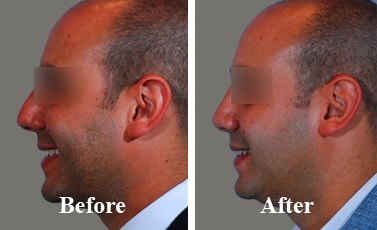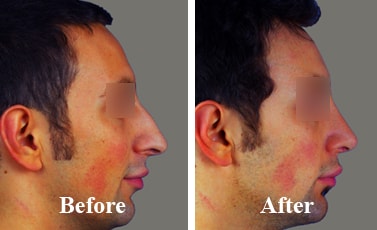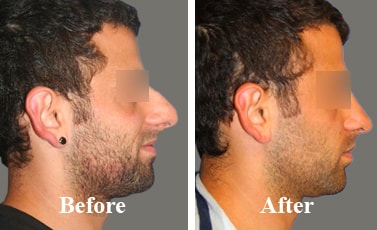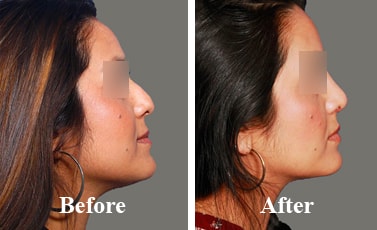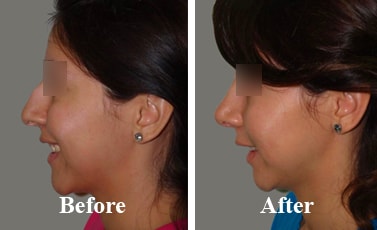Reshape Your Nose As You Want
WhatsApp : 8329060384
Best Rhinoplasty Surgeon in Gurgaon Get Your Nose Reshaped from Best Surgeon!
Rhinoplasty Surgery Clinic in Gurgaon, India - Rhinoplasty, sometimes referred to as a "nose job" or "nose reshaping" by patients is a plastic surgery procedure for correcting and reconstructing the form, restoring the functions, and aesthetically enhancing the nose. Most patients ask to remove a bump, narrow nostril width, change the angle between the nose and the mouth, as well as correct injuries, birth defects, or other problems that affect breathing. Find the best Rhinoplasty Clinic in Gurgaon, India.
[forminator_form id="42596"]
CALL NOW & GET DISCOUNT: 8329060384
Free Consultation, Best Treatment, Lowest Cost, Easy Finance Available, 100% Result
Rhinoplasty Surgery Cost in Gurgaon Know the Cost of Nose Job, Deals & Offers in Gurgaon
Rhinoplasty Cost Depends on?
Nose surgery costs in Gurgaon, India - Rhinoplasty surgery costs can vary widely. The cost of Rhinoplasty Surgery depends on Anesthesia fees, Hospital or surgical facility costs, Medical tests, Post-surgery garments, Prescriptions for medication, Surgeons fee, Clinic stay etc. A surgeons fee will be based on his or her experience and geographic office location. When choosing a board-certified plastic surgeon in your area for a rhinoplasty procedure, remember that the surgeons experience and your comfort with him or her are just as important as the final cost of the surgery.
Fill the form to know the approx cost of Nose surgery for your case in Gurgaon, India.
[forminator_form id="42596"]
The information on this site is intended for general purposes only and is not intended to nor implied to be a substitute for professional medical advice relative to specific medical conditions or questions. The information on this website is not a guide to treatment, and it should not replace seeking medical advice from your physician. We do not warrant the accuracy, completeness, correctness, timeliness or usefulness of any information contained herein. In no event rhinoplastysurgery.co.in be liable to anyone for any decision made or action taken in reliance upon the information provided through this website. The photos on this website are of models & are not intended to represent the results that every patient can expect. Surgical results vary greatly from patient to patient and are not guaranteed.
Rhinoplasty Nose Surgery in pune
Rhinoplasty
The nose is a central element of the human personality. It is the focus of visual attention and has a significant impact on the aesthetic effect of the face. Anyone who is dissatisfied with the shape of their nose therefore feels a high level of personal suffering and a weakening of self-esteem. Often the disturbance of the external shape also leads to impaired nasal breathing. Therefore, with every nose operation it must be checked whether the internal structures of the nose also need to be corrected. A deterioration in nasal breathing due to the aesthetic improvement in the shape of the nose must also be avoided at all costs.
During the procedure, the nose can be straightened, made smaller, or enlarged. The tip of the nose and nostrils can also be corrected. The surgical techniques have continuously improved in recent years. By opening the nose with the help of a later barely visible incision between the nostrils, the operation can now be carried out much more precisely and with greater security than before.
Young people who want a rhinoplasty need to be given particularly detailed information about the procedure. For medical reasons, young people can also be operated on without any problems. However, you should be able to estimate what lasting consequences the procedure will have for your external appearance. In order not to affect the growth of the nose, the procedure should only be carried out after puberty. An operation on minors requires the consent of their parents / legal guardians.
A nose job is an attempt to change shape and size according to your ideas. The main aim of the operation is to change the nose in harmony with the other facial operations. An inconspicuous shape of the nose has to be created that does not show that the nose has been operated on. As far as possible, the individuality of the patient should not be changed. At the same time, the breathing function must be maintained.
The skin is a crucial factor in any nose operation. In most cases, the nose is made smaller and the skin has to be adapted to the changed nasal framework. With thick, coarse-pored skin, this is usually only possible to a limited extent, while thin skin has the disadvantage that you can not only feel but also see all the irregularities under the skin.
The conversation with the specialist
A prerequisite for a successful operation is a detailed discussion about the details of the operation and possible complications. Take the opportunity to clarify all important questions. Write down what you want to know. If necessary, take someone with you. If you still have questions after the interview, make another appointment or call your doctor. There should be enough time to think about it between the preliminary discussion and the operation.
Some plastic surgeons use a computer simulation to show the patient the desired shape of the nose. However, such a simulation is not an exact prognosis. The patient cannot assume that the result of the operation corresponds to the picture one to one. Some plastic surgeons therefore prefer to discuss the procedure with the patient on the basis of retouched photos.
Before the operation, the plastic surgeon will discuss a declaration of consent with you. This contains your personal data, information about the type of treatment and the possible complications discussed. With your signature you agree to the procedure and assure that you have been informed about the risks.
If complications arise or you are dissatisfied with the outcome of the procedure, follow-up operations can be carried out. In the case of "medically not indicated aesthetic operations" (SGB V § 52), the statutory health insurance is obliged to give you an appropriate share in the costs of the follow-up operations in the event of fateful complications for which the doctor was not responsible. Before the first procedure, you can insure yourself against the risk of these follow-up costs. Ask your plastic surgeon about this option.
Before the rhinoplasty
You should not take pain relievers containing acetylsalicylic acid (e.g. aspirin) for 14 days before the operation. The blood-thinning effect not only delays blood clotting and can lead to secondary bleeding - the increased bleeding makes it more difficult to assess the shape of the nose during the procedure. Before the procedure, reduce your consumption of nicotine and alcohol to a minimum.
If you take medication regularly or if you suffer from allergies (e.g. to medication, disinfectants or plasters), please inform your doctor. Make sure you also inform him about known diseases. If you are prone to bruising or persistent bleeding after minor injuries, the plastic surgeon should absolutely rule out a coagulation disorder before the operation.
During the preliminary examination, the function of breathing and the condition of the nasal mucous membranes are checked. If you are taking birth control pills, you should clarify with your gynecologist whether it is necessary to prevent the risk of thrombosis through appropriate drug treatment. Chronic inflammation of the nose, throat and ears should be clarified and treated in good time.
As a rule, a rhinoplasty is carried out in-patient in a hospital. A stay of one or two nights makes sense. The patient's recovery can thus be ideally monitored medically.
Rhinoplasty can be performed under general anesthesia or in twilight sleep. It is best to discuss with your plastic surgeon which preliminary examinations are necessary and when they will be carried out. You will also have the opportunity to discuss the anesthesia with the anesthetist.
The operation
A nose job usually takes one to three hours. Depending on the complexity of the procedure, more time may be required. To prevent bleeding of the mucous membranes, you will be given a vasoconstrictor during the anesthesia.
To change the shape of the nose, the skin and mucous membranes are temporarily detached from the cartilage and bones. Whereas in the past the operation was mostly carried out from inside the nose, today the so-called "open rhinoplasty" has established itself. This means that a small incision is made between the nostrils and the nose is "opened". As a result, the structures can be better assessed and the changes can be made much more precisely. With special mini-instruments (e.g. hammer, chisel, scalpel), the excess bone and cartilage structure of a humped nose can be removed and the nose narrowed, a nose that is too long shortened or the tip of the nose reshaped. Crooked noses are almost always accompanied or caused by a misalignment of the nasal septum,which can also interfere with nasal breathing. Therefore, in these cases straightening the nasal septum is a prerequisite for straightening the outer nose. In the case of saddle noses, it is necessary to build up the bridge of the nose, which should be done using the body's own material (e.g. cartilage from the nasal septum, the auricle or the rib).
After modeling the cartilage, the mucous membranes are put back exactly and sewn with fine, self-dissolving threads. In addition, the inner nasal passages are splinted with soft nasal packing or ointment gauze. The skin of the nose is modeled with fine plaster strips and the shape of the nose is supported by a splint made of plastic or plaster of paris.
After the rhinoplasty
Immediately after the procedure, pain in the wound area, headache and clearly visible swellings and bruises in the cheek and lower eyelid area can be expected. Both recede, but this can sometimes take longer. The outer plastic splint of the nose is usually changed after a week, as the nose is already clearly swollen at this point. How long it takes to tampon the nose depends on the extent of the operation in the area of the nasal septum. After the shining bandage has been removed, the nose is usually provided with a tape bandage for a week to reduce the tendency to swell. You shouldn't blow your nose for the first three to four weeks. It does not make sense to lie in bed after the operation. The earlier you get up and the more you move,the faster the cycle gets going again. You have to expect that you will wear a bandage for three weeks and only be “socially acceptable” to a limited extent. It depends on the individual case whether a splint or just a tape bandage is required.
Only the sutures in the area between the nostrils need to be removed after a few days. The remaining seams dissolve by themselves - but this can often take half a year. In order to enable the swelling to swell as quickly as possible, one should not undertake any heavy physical exertion for eight to twelve weeks and therefore limit sports activities accordingly. Direct sunlight, saunas and steam baths should also be avoided. Since wearing glasses can affect the changed bone structure, this should also be avoided for eight to twelve weeks.
The rhinoplasty can in principle be repeated, but then the procedure is more difficult and the result even more difficult to predict. Before operating a nose again, you should wait at least a year.
What complications can arise?
Every operation involves risks. The risks of a rhinoplasty can be minimized if the operation is performed by a qualified plastic surgeon with sufficient experience. Despite the utmost care, as with any surgical procedure, complications can occasionally occur during or after the operation.
In general, there is a risk of bruising and bleeding. Infections can lead to impaired wound healing. Blood clots can block blood vessels (thrombosis) or get into the lungs (pulmonary embolism). The administration of drugs or narcotics can lead to allergies and intolerance. If blood transfusions are necessary, an infection cannot be excluded with all precautionary measures. After the operation, numbness from pressed nerves or other positional damage may occur, but these usually subside.
With any rhinoplasty there is a risk that reoperation may be necessary. This does not necessarily have to do with the surgical skills of the attending physician, but often depends on the individual anatomical conditions.
Rhinoplasty is one of the most difficult aesthetic procedures on the face. After such an operation, swelling inevitably occurs and the nose changes over time. The new shape of the nose can usually only be assessed after about six to twelve months. The sensory sensitivity of the tip of the nose in particular can be impaired for many months. Serious complications such as purulent infections, injuries to the tear duct or embolism are very rare. Interventions in the area of the nasal septum and erectile tissue can lead to dryness of the nose. Occasionally there is a hole in the nasal septum - a renewed misalignment cannot be ruled out. Smaller irregularities, especially in the area of the bridge of the nose, often take months to become apparent.In such cases, minor corrections are required.
Tips for choosing a doctor
You should allow yourself enough time to choose the right doctor. Be clear about what is bothering you about your appearance and what expectations you have in the operation. Also ask your family doctor which plastic surgeon he recommends.
Choosing an appropriately trained specialist is a prerequisite for a satisfactory operation result. We urgently recommend choosing a specialist in plastic and aesthetic surgery who has many years of advanced training. Together with you, he will select the appropriate surgical method in advance and clarify the possibilities, limits and alternatives of the planned procedure.
The plastic surgeon is a recognized specialist who completed six years of advanced training after completing his medical degree. During this time he has to perform numerous operations under supervision. After this practical experience and theoretical training, the doctor must take the specialist examination at the respective state medical association. Only then does he officially receive the title of "Specialist in Plastic and Aesthetic Surgery" (the expiring title of "Specialist in Plastic Surgery" is also currently being used, the further training of which was comparable) and thus for you, the patient, clear evidence of comprehensive qualifications.
Only the title “Specialist in Plastic and Aesthetic Surgery” (or “Specialist in Plastic Surgery”) is protected. Other terms such as “cosmetic surgeon”, “cosmetic surgeon” or “aesthetic surgeon” are not protected titles and can be used by any doctor without proven further training. They say nothing about their training or further education.
